Financial Decision Making and Ratio Analysis of Skanska plc Report
VerifiedAdded on 2022/11/30
|15
|3336
|190
Report
AI Summary
This report delves into the complexities of financial decision-making within organizations, using Skanska plc as a case study. It begins with an introduction to financial decision-making and its importance, followed by an overview of Skanska plc, including its background, strengths, weaknesses, opportunities, and threats. The report then explores the accounting and finance functions, detailing their roles, duties, and the importance of financial statements. Key accounting techniques like financial planning, financial statement analysis, and cost accounting are also discussed. The second part of the report focuses on analyzing Skanska plc's financial performance through ratio analysis, including Return on Capital Employed (ROCE), Net Profit Margin, and Current Ratio, providing interpretations and implications for the company's financial health. This report is a comprehensive analysis of financial management principles and their application in a real-world business context.

Financial Decision
Making
Making
Paraphrase This Document
Need a fresh take? Get an instant paraphrase of this document with our AI Paraphraser

Table of Contents
Introduction-................................................................................................................................................3
Task 1-.........................................................................................................................................................4
Task 2-.........................................................................................................................................................6
Conclusion-...............................................................................................................................................10
References-................................................................................................................................................10
Introduction-................................................................................................................................................3
Task 1-.........................................................................................................................................................4
Task 2-.........................................................................................................................................................6
Conclusion-...............................................................................................................................................10
References-................................................................................................................................................10
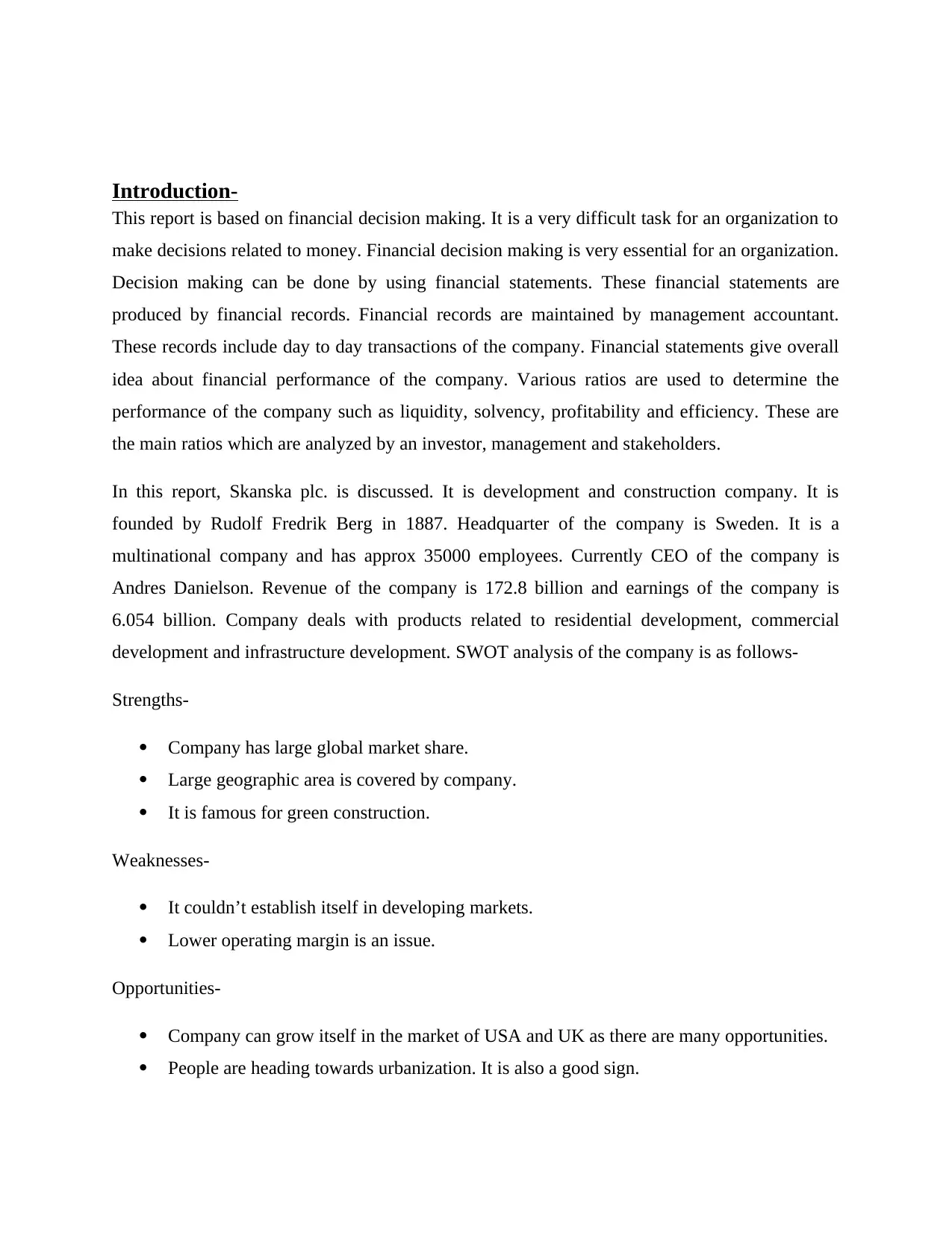
Introduction-
This report is based on financial decision making. It is a very difficult task for an organization to
make decisions related to money. Financial decision making is very essential for an organization.
Decision making can be done by using financial statements. These financial statements are
produced by financial records. Financial records are maintained by management accountant.
These records include day to day transactions of the company. Financial statements give overall
idea about financial performance of the company. Various ratios are used to determine the
performance of the company such as liquidity, solvency, profitability and efficiency. These are
the main ratios which are analyzed by an investor, management and stakeholders.
In this report, Skanska plc. is discussed. It is development and construction company. It is
founded by Rudolf Fredrik Berg in 1887. Headquarter of the company is Sweden. It is a
multinational company and has approx 35000 employees. Currently CEO of the company is
Andres Danielson. Revenue of the company is 172.8 billion and earnings of the company is
6.054 billion. Company deals with products related to residential development, commercial
development and infrastructure development. SWOT analysis of the company is as follows-
Strengths-
Company has large global market share.
Large geographic area is covered by company.
It is famous for green construction.
Weaknesses-
It couldn’t establish itself in developing markets.
Lower operating margin is an issue.
Opportunities-
Company can grow itself in the market of USA and UK as there are many opportunities.
People are heading towards urbanization. It is also a good sign.
This report is based on financial decision making. It is a very difficult task for an organization to
make decisions related to money. Financial decision making is very essential for an organization.
Decision making can be done by using financial statements. These financial statements are
produced by financial records. Financial records are maintained by management accountant.
These records include day to day transactions of the company. Financial statements give overall
idea about financial performance of the company. Various ratios are used to determine the
performance of the company such as liquidity, solvency, profitability and efficiency. These are
the main ratios which are analyzed by an investor, management and stakeholders.
In this report, Skanska plc. is discussed. It is development and construction company. It is
founded by Rudolf Fredrik Berg in 1887. Headquarter of the company is Sweden. It is a
multinational company and has approx 35000 employees. Currently CEO of the company is
Andres Danielson. Revenue of the company is 172.8 billion and earnings of the company is
6.054 billion. Company deals with products related to residential development, commercial
development and infrastructure development. SWOT analysis of the company is as follows-
Strengths-
Company has large global market share.
Large geographic area is covered by company.
It is famous for green construction.
Weaknesses-
It couldn’t establish itself in developing markets.
Lower operating margin is an issue.
Opportunities-
Company can grow itself in the market of USA and UK as there are many opportunities.
People are heading towards urbanization. It is also a good sign.
⊘ This is a preview!⊘
Do you want full access?
Subscribe today to unlock all pages.

Trusted by 1+ million students worldwide
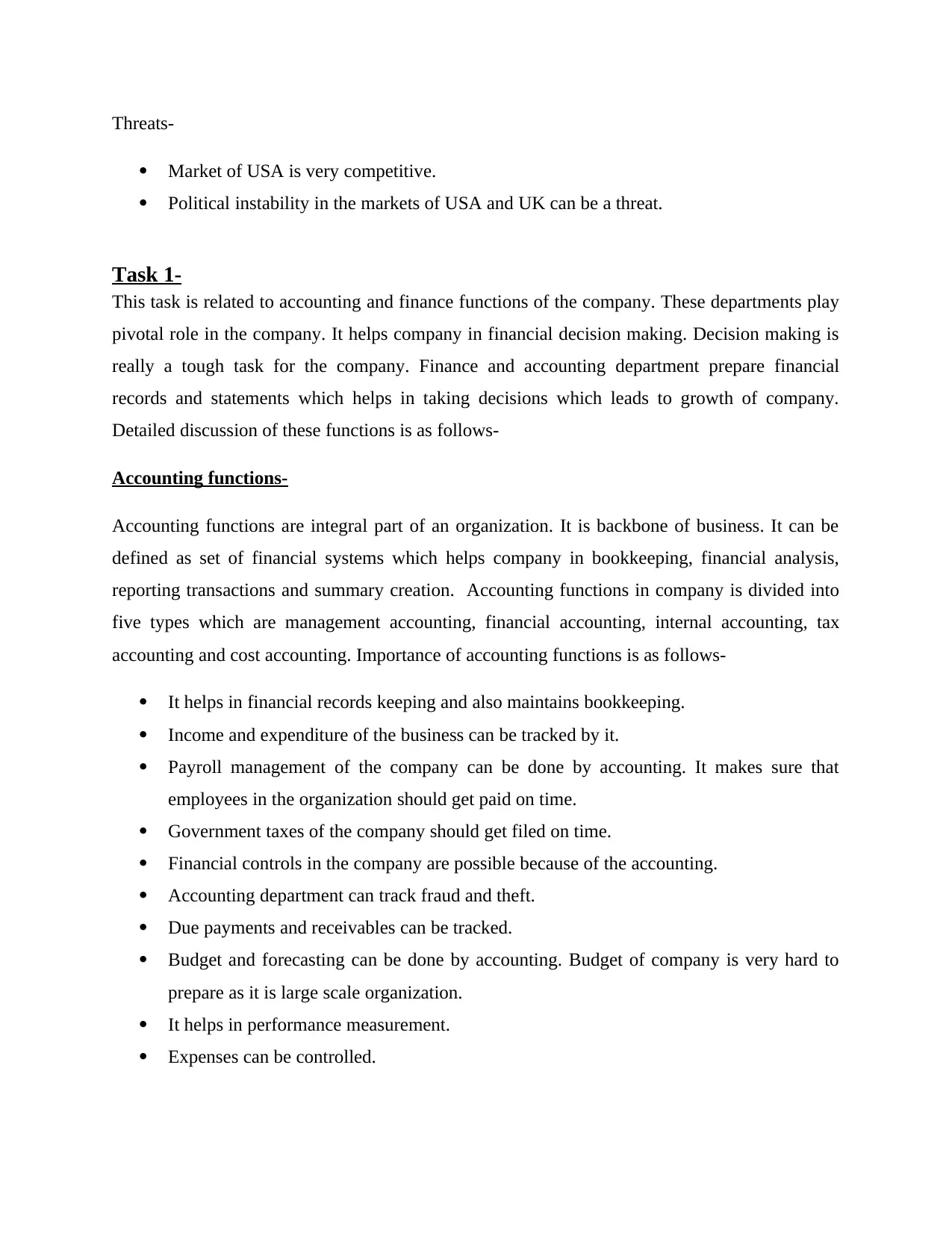
Threats-
Market of USA is very competitive.
Political instability in the markets of USA and UK can be a threat.
Task 1-
This task is related to accounting and finance functions of the company. These departments play
pivotal role in the company. It helps company in financial decision making. Decision making is
really a tough task for the company. Finance and accounting department prepare financial
records and statements which helps in taking decisions which leads to growth of company.
Detailed discussion of these functions is as follows-
Accounting functions-
Accounting functions are integral part of an organization. It is backbone of business. It can be
defined as set of financial systems which helps company in bookkeeping, financial analysis,
reporting transactions and summary creation. Accounting functions in company is divided into
five types which are management accounting, financial accounting, internal accounting, tax
accounting and cost accounting. Importance of accounting functions is as follows-
It helps in financial records keeping and also maintains bookkeeping.
Income and expenditure of the business can be tracked by it.
Payroll management of the company can be done by accounting. It makes sure that
employees in the organization should get paid on time.
Government taxes of the company should get filed on time.
Financial controls in the company are possible because of the accounting.
Accounting department can track fraud and theft.
Due payments and receivables can be tracked.
Budget and forecasting can be done by accounting. Budget of company is very hard to
prepare as it is large scale organization.
It helps in performance measurement.
Expenses can be controlled.
Market of USA is very competitive.
Political instability in the markets of USA and UK can be a threat.
Task 1-
This task is related to accounting and finance functions of the company. These departments play
pivotal role in the company. It helps company in financial decision making. Decision making is
really a tough task for the company. Finance and accounting department prepare financial
records and statements which helps in taking decisions which leads to growth of company.
Detailed discussion of these functions is as follows-
Accounting functions-
Accounting functions are integral part of an organization. It is backbone of business. It can be
defined as set of financial systems which helps company in bookkeeping, financial analysis,
reporting transactions and summary creation. Accounting functions in company is divided into
five types which are management accounting, financial accounting, internal accounting, tax
accounting and cost accounting. Importance of accounting functions is as follows-
It helps in financial records keeping and also maintains bookkeeping.
Income and expenditure of the business can be tracked by it.
Payroll management of the company can be done by accounting. It makes sure that
employees in the organization should get paid on time.
Government taxes of the company should get filed on time.
Financial controls in the company are possible because of the accounting.
Accounting department can track fraud and theft.
Due payments and receivables can be tracked.
Budget and forecasting can be done by accounting. Budget of company is very hard to
prepare as it is large scale organization.
It helps in performance measurement.
Expenses can be controlled.
Paraphrase This Document
Need a fresh take? Get an instant paraphrase of this document with our AI Paraphraser
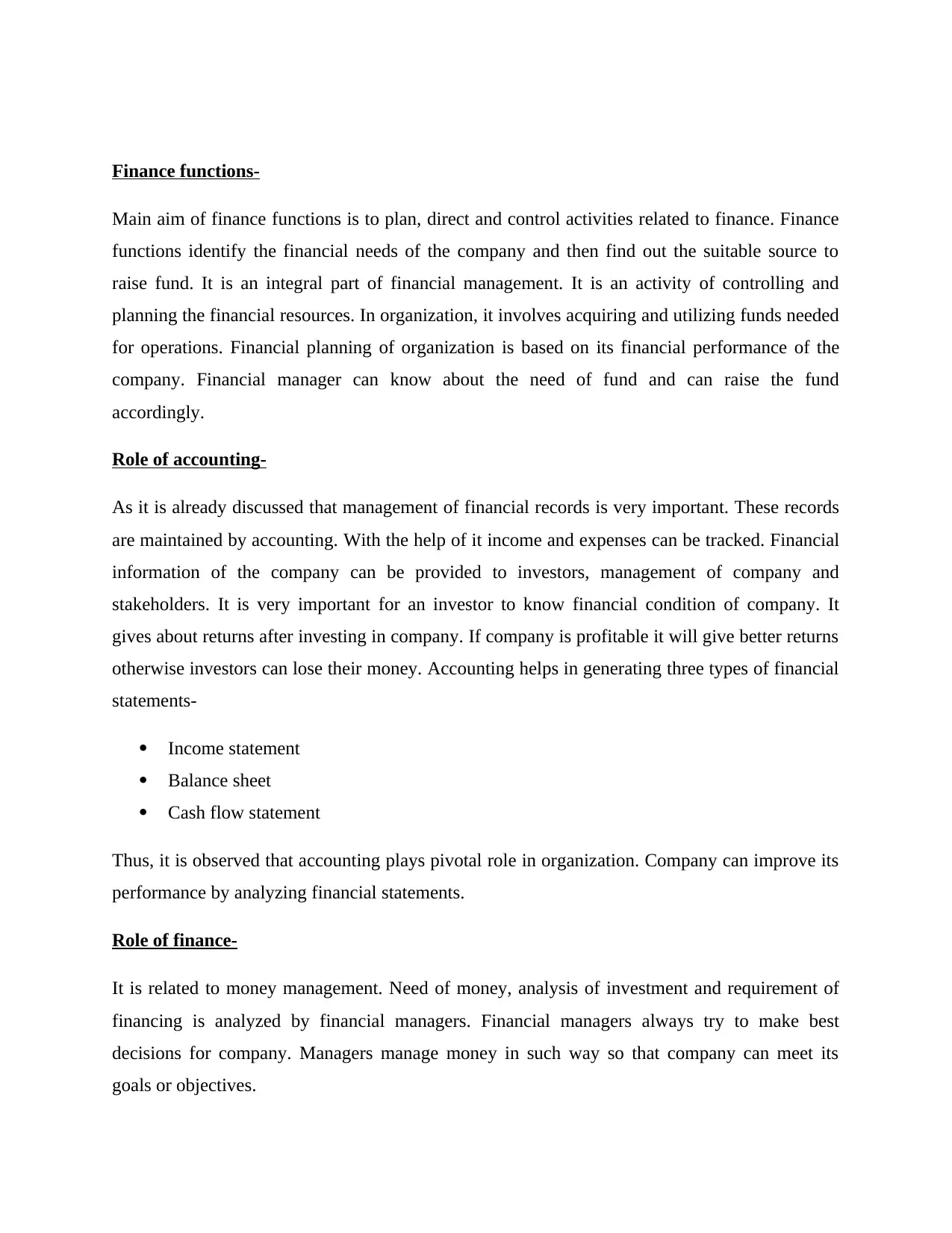
Finance functions-
Main aim of finance functions is to plan, direct and control activities related to finance. Finance
functions identify the financial needs of the company and then find out the suitable source to
raise fund. It is an integral part of financial management. It is an activity of controlling and
planning the financial resources. In organization, it involves acquiring and utilizing funds needed
for operations. Financial planning of organization is based on its financial performance of the
company. Financial manager can know about the need of fund and can raise the fund
accordingly.
Role of accounting-
As it is already discussed that management of financial records is very important. These records
are maintained by accounting. With the help of it income and expenses can be tracked. Financial
information of the company can be provided to investors, management of company and
stakeholders. It is very important for an investor to know financial condition of company. It
gives about returns after investing in company. If company is profitable it will give better returns
otherwise investors can lose their money. Accounting helps in generating three types of financial
statements-
Income statement
Balance sheet
Cash flow statement
Thus, it is observed that accounting plays pivotal role in organization. Company can improve its
performance by analyzing financial statements.
Role of finance-
It is related to money management. Need of money, analysis of investment and requirement of
financing is analyzed by financial managers. Financial managers always try to make best
decisions for company. Managers manage money in such way so that company can meet its
goals or objectives.
Main aim of finance functions is to plan, direct and control activities related to finance. Finance
functions identify the financial needs of the company and then find out the suitable source to
raise fund. It is an integral part of financial management. It is an activity of controlling and
planning the financial resources. In organization, it involves acquiring and utilizing funds needed
for operations. Financial planning of organization is based on its financial performance of the
company. Financial manager can know about the need of fund and can raise the fund
accordingly.
Role of accounting-
As it is already discussed that management of financial records is very important. These records
are maintained by accounting. With the help of it income and expenses can be tracked. Financial
information of the company can be provided to investors, management of company and
stakeholders. It is very important for an investor to know financial condition of company. It
gives about returns after investing in company. If company is profitable it will give better returns
otherwise investors can lose their money. Accounting helps in generating three types of financial
statements-
Income statement
Balance sheet
Cash flow statement
Thus, it is observed that accounting plays pivotal role in organization. Company can improve its
performance by analyzing financial statements.
Role of finance-
It is related to money management. Need of money, analysis of investment and requirement of
financing is analyzed by financial managers. Financial managers always try to make best
decisions for company. Managers manage money in such way so that company can meet its
goals or objectives.
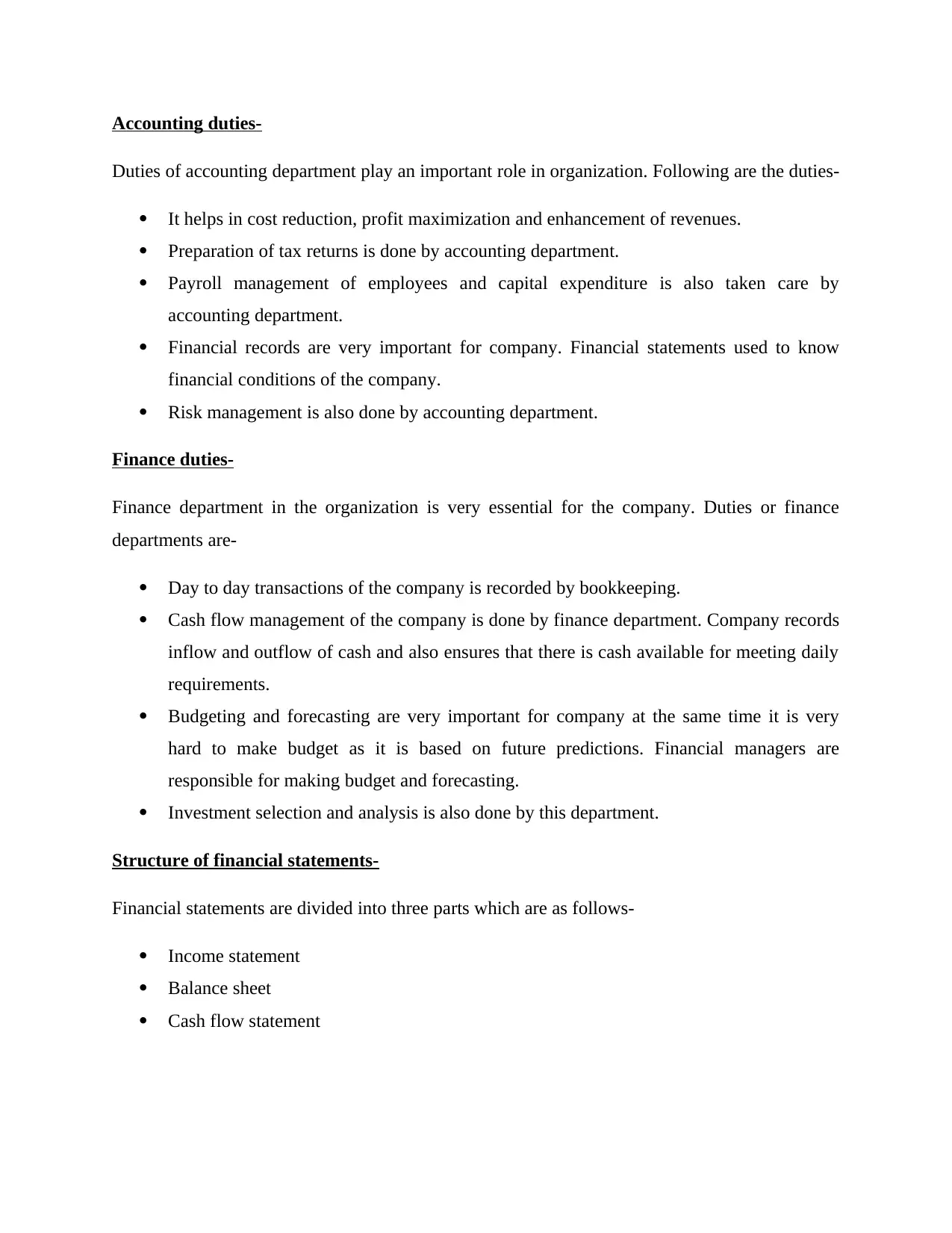
Accounting duties-
Duties of accounting department play an important role in organization. Following are the duties-
It helps in cost reduction, profit maximization and enhancement of revenues.
Preparation of tax returns is done by accounting department.
Payroll management of employees and capital expenditure is also taken care by
accounting department.
Financial records are very important for company. Financial statements used to know
financial conditions of the company.
Risk management is also done by accounting department.
Finance duties-
Finance department in the organization is very essential for the company. Duties or finance
departments are-
Day to day transactions of the company is recorded by bookkeeping.
Cash flow management of the company is done by finance department. Company records
inflow and outflow of cash and also ensures that there is cash available for meeting daily
requirements.
Budgeting and forecasting are very important for company at the same time it is very
hard to make budget as it is based on future predictions. Financial managers are
responsible for making budget and forecasting.
Investment selection and analysis is also done by this department.
Structure of financial statements-
Financial statements are divided into three parts which are as follows-
Income statement
Balance sheet
Cash flow statement
Duties of accounting department play an important role in organization. Following are the duties-
It helps in cost reduction, profit maximization and enhancement of revenues.
Preparation of tax returns is done by accounting department.
Payroll management of employees and capital expenditure is also taken care by
accounting department.
Financial records are very important for company. Financial statements used to know
financial conditions of the company.
Risk management is also done by accounting department.
Finance duties-
Finance department in the organization is very essential for the company. Duties or finance
departments are-
Day to day transactions of the company is recorded by bookkeeping.
Cash flow management of the company is done by finance department. Company records
inflow and outflow of cash and also ensures that there is cash available for meeting daily
requirements.
Budgeting and forecasting are very important for company at the same time it is very
hard to make budget as it is based on future predictions. Financial managers are
responsible for making budget and forecasting.
Investment selection and analysis is also done by this department.
Structure of financial statements-
Financial statements are divided into three parts which are as follows-
Income statement
Balance sheet
Cash flow statement
⊘ This is a preview!⊘
Do you want full access?
Subscribe today to unlock all pages.

Trusted by 1+ million students worldwide
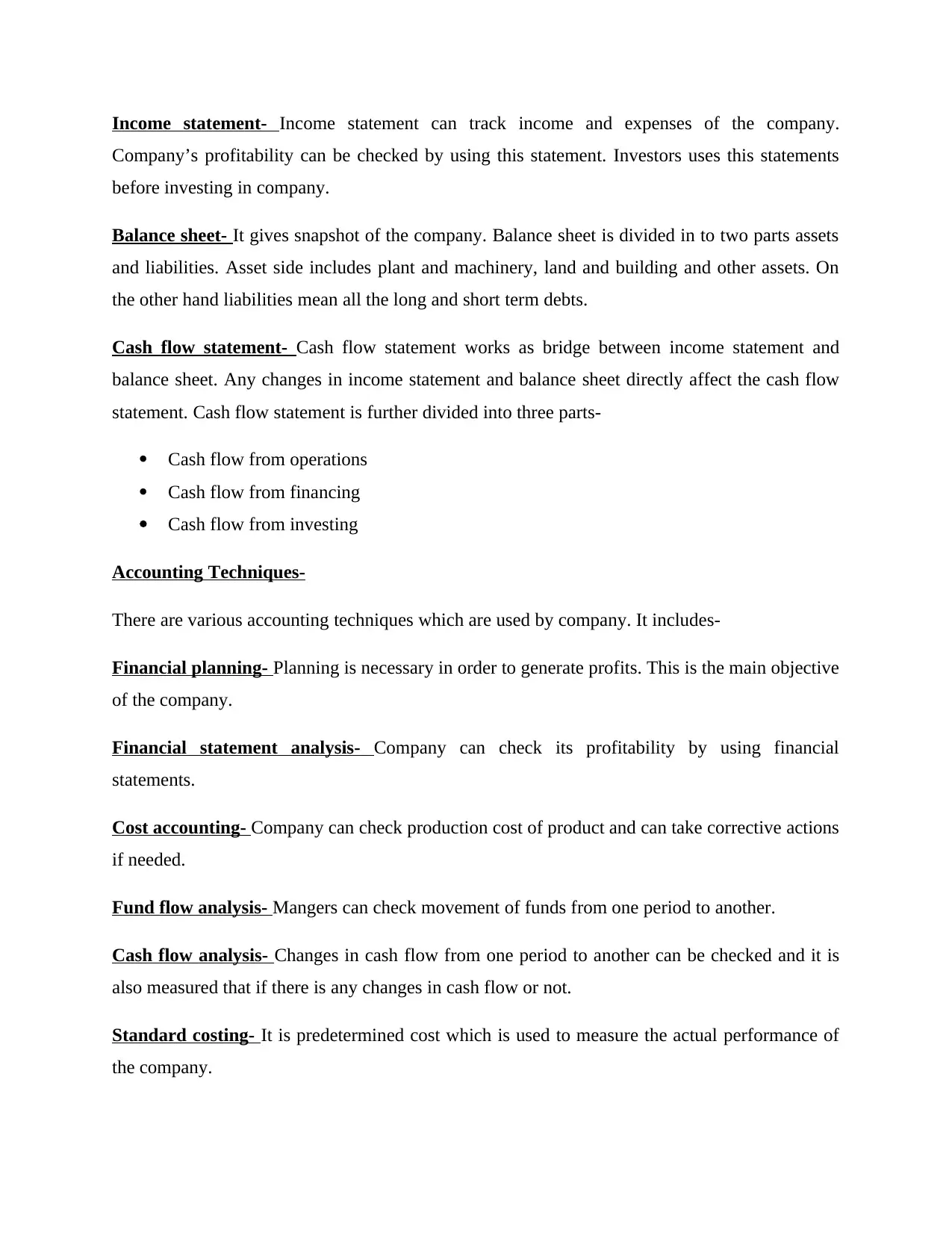
Income statement- Income statement can track income and expenses of the company.
Company’s profitability can be checked by using this statement. Investors uses this statements
before investing in company.
Balance sheet- It gives snapshot of the company. Balance sheet is divided in to two parts assets
and liabilities. Asset side includes plant and machinery, land and building and other assets. On
the other hand liabilities mean all the long and short term debts.
Cash flow statement- Cash flow statement works as bridge between income statement and
balance sheet. Any changes in income statement and balance sheet directly affect the cash flow
statement. Cash flow statement is further divided into three parts-
Cash flow from operations
Cash flow from financing
Cash flow from investing
Accounting Techniques-
There are various accounting techniques which are used by company. It includes-
Financial planning- Planning is necessary in order to generate profits. This is the main objective
of the company.
Financial statement analysis- Company can check its profitability by using financial
statements.
Cost accounting- Company can check production cost of product and can take corrective actions
if needed.
Fund flow analysis- Mangers can check movement of funds from one period to another.
Cash flow analysis- Changes in cash flow from one period to another can be checked and it is
also measured that if there is any changes in cash flow or not.
Standard costing- It is predetermined cost which is used to measure the actual performance of
the company.
Company’s profitability can be checked by using this statement. Investors uses this statements
before investing in company.
Balance sheet- It gives snapshot of the company. Balance sheet is divided in to two parts assets
and liabilities. Asset side includes plant and machinery, land and building and other assets. On
the other hand liabilities mean all the long and short term debts.
Cash flow statement- Cash flow statement works as bridge between income statement and
balance sheet. Any changes in income statement and balance sheet directly affect the cash flow
statement. Cash flow statement is further divided into three parts-
Cash flow from operations
Cash flow from financing
Cash flow from investing
Accounting Techniques-
There are various accounting techniques which are used by company. It includes-
Financial planning- Planning is necessary in order to generate profits. This is the main objective
of the company.
Financial statement analysis- Company can check its profitability by using financial
statements.
Cost accounting- Company can check production cost of product and can take corrective actions
if needed.
Fund flow analysis- Mangers can check movement of funds from one period to another.
Cash flow analysis- Changes in cash flow from one period to another can be checked and it is
also measured that if there is any changes in cash flow or not.
Standard costing- It is predetermined cost which is used to measure the actual performance of
the company.
Paraphrase This Document
Need a fresh take? Get an instant paraphrase of this document with our AI Paraphraser
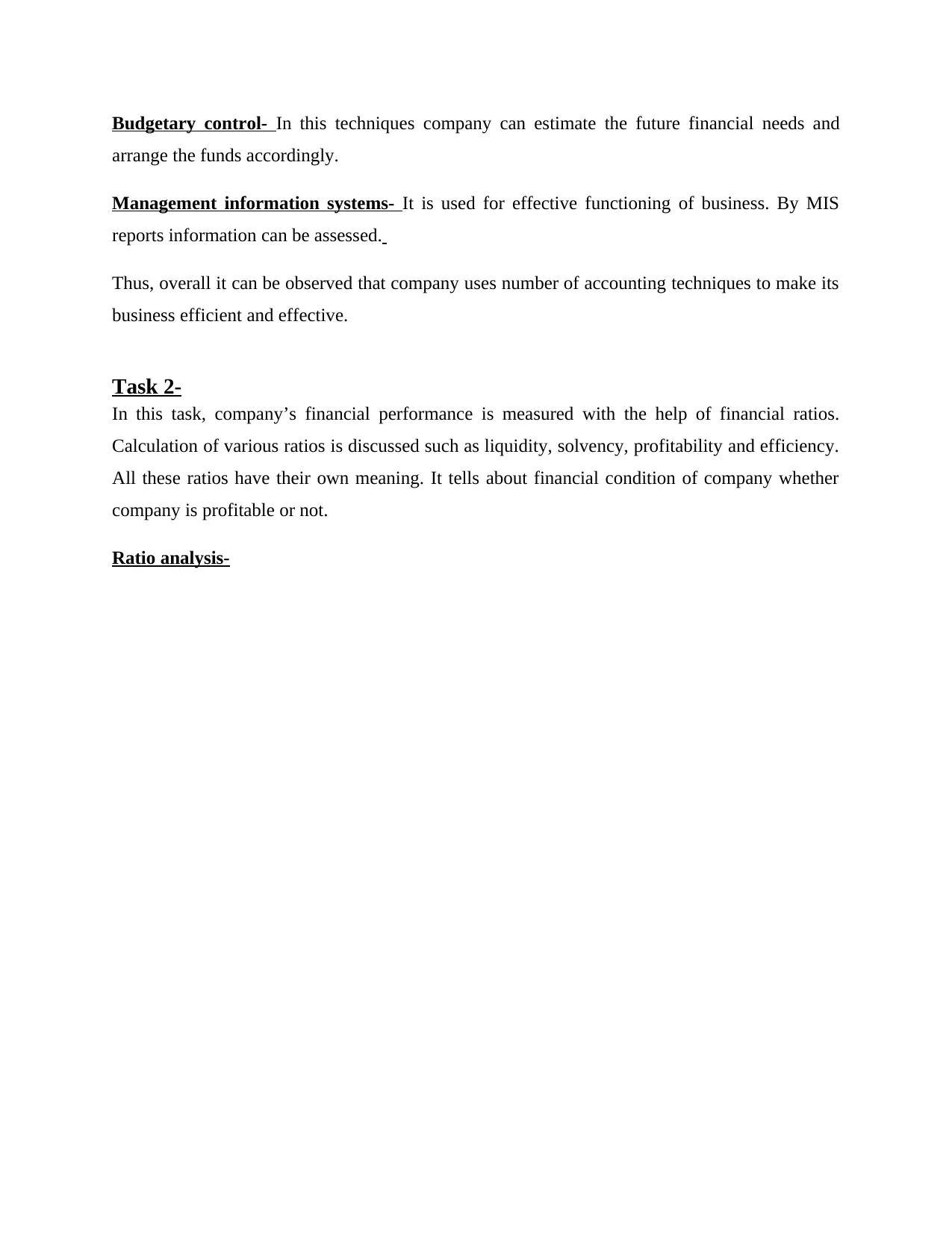
Budgetary control- In this techniques company can estimate the future financial needs and
arrange the funds accordingly.
Management information systems- It is used for effective functioning of business. By MIS
reports information can be assessed.
Thus, overall it can be observed that company uses number of accounting techniques to make its
business efficient and effective.
Task 2-
In this task, company’s financial performance is measured with the help of financial ratios.
Calculation of various ratios is discussed such as liquidity, solvency, profitability and efficiency.
All these ratios have their own meaning. It tells about financial condition of company whether
company is profitable or not.
Ratio analysis-
arrange the funds accordingly.
Management information systems- It is used for effective functioning of business. By MIS
reports information can be assessed.
Thus, overall it can be observed that company uses number of accounting techniques to make its
business efficient and effective.
Task 2-
In this task, company’s financial performance is measured with the help of financial ratios.
Calculation of various ratios is discussed such as liquidity, solvency, profitability and efficiency.
All these ratios have their own meaning. It tells about financial condition of company whether
company is profitable or not.
Ratio analysis-
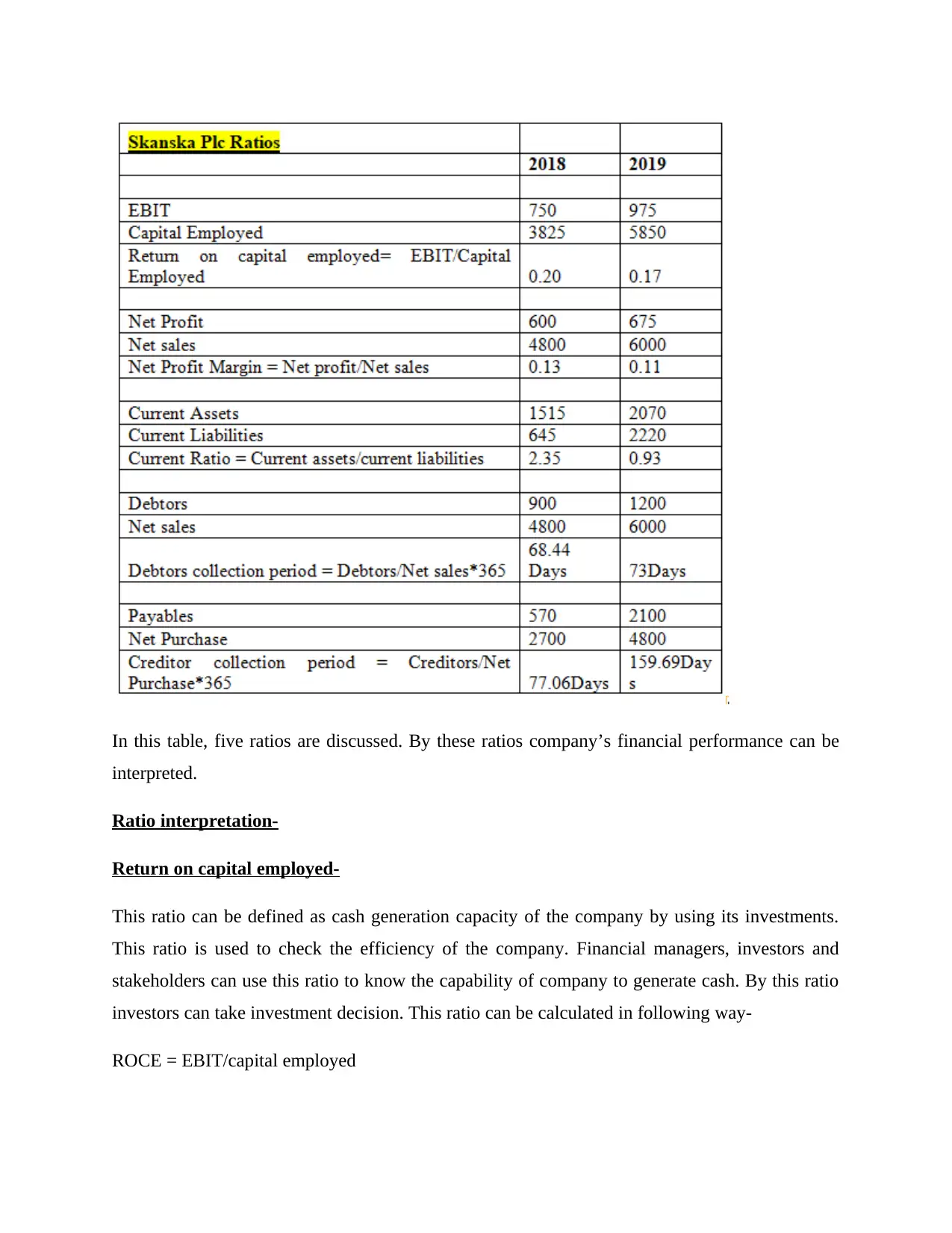
In this table, five ratios are discussed. By these ratios company’s financial performance can be
interpreted.
Ratio interpretation-
Return on capital employed-
This ratio can be defined as cash generation capacity of the company by using its investments.
This ratio is used to check the efficiency of the company. Financial managers, investors and
stakeholders can use this ratio to know the capability of company to generate cash. By this ratio
investors can take investment decision. This ratio can be calculated in following way-
ROCE = EBIT/capital employed
interpreted.
Ratio interpretation-
Return on capital employed-
This ratio can be defined as cash generation capacity of the company by using its investments.
This ratio is used to check the efficiency of the company. Financial managers, investors and
stakeholders can use this ratio to know the capability of company to generate cash. By this ratio
investors can take investment decision. This ratio can be calculated in following way-
ROCE = EBIT/capital employed
⊘ This is a preview!⊘
Do you want full access?
Subscribe today to unlock all pages.

Trusted by 1+ million students worldwide
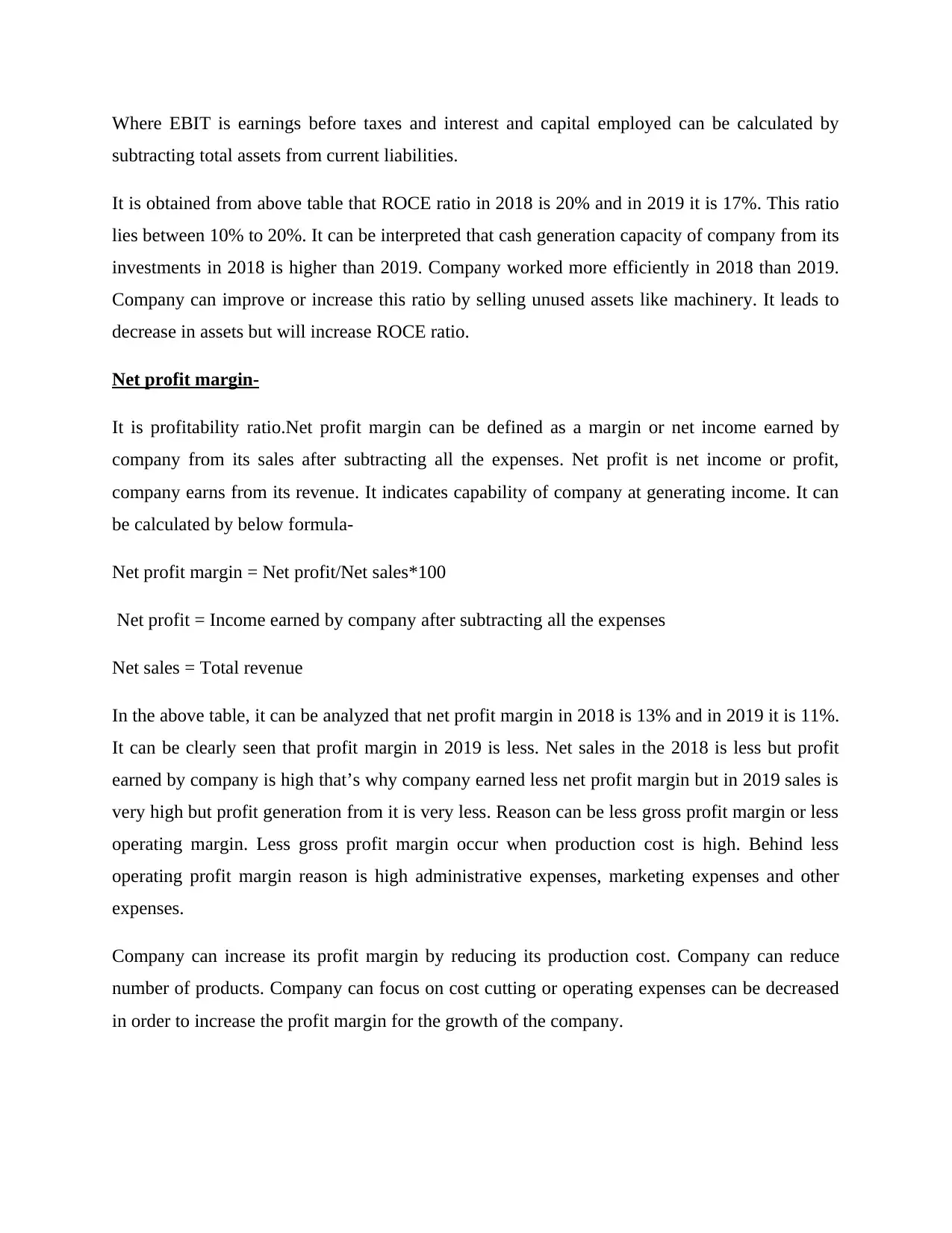
Where EBIT is earnings before taxes and interest and capital employed can be calculated by
subtracting total assets from current liabilities.
It is obtained from above table that ROCE ratio in 2018 is 20% and in 2019 it is 17%. This ratio
lies between 10% to 20%. It can be interpreted that cash generation capacity of company from its
investments in 2018 is higher than 2019. Company worked more efficiently in 2018 than 2019.
Company can improve or increase this ratio by selling unused assets like machinery. It leads to
decrease in assets but will increase ROCE ratio.
Net profit margin-
It is profitability ratio.Net profit margin can be defined as a margin or net income earned by
company from its sales after subtracting all the expenses. Net profit is net income or profit,
company earns from its revenue. It indicates capability of company at generating income. It can
be calculated by below formula-
Net profit margin = Net profit/Net sales*100
Net profit = Income earned by company after subtracting all the expenses
Net sales = Total revenue
In the above table, it can be analyzed that net profit margin in 2018 is 13% and in 2019 it is 11%.
It can be clearly seen that profit margin in 2019 is less. Net sales in the 2018 is less but profit
earned by company is high that’s why company earned less net profit margin but in 2019 sales is
very high but profit generation from it is very less. Reason can be less gross profit margin or less
operating margin. Less gross profit margin occur when production cost is high. Behind less
operating profit margin reason is high administrative expenses, marketing expenses and other
expenses.
Company can increase its profit margin by reducing its production cost. Company can reduce
number of products. Company can focus on cost cutting or operating expenses can be decreased
in order to increase the profit margin for the growth of the company.
subtracting total assets from current liabilities.
It is obtained from above table that ROCE ratio in 2018 is 20% and in 2019 it is 17%. This ratio
lies between 10% to 20%. It can be interpreted that cash generation capacity of company from its
investments in 2018 is higher than 2019. Company worked more efficiently in 2018 than 2019.
Company can improve or increase this ratio by selling unused assets like machinery. It leads to
decrease in assets but will increase ROCE ratio.
Net profit margin-
It is profitability ratio.Net profit margin can be defined as a margin or net income earned by
company from its sales after subtracting all the expenses. Net profit is net income or profit,
company earns from its revenue. It indicates capability of company at generating income. It can
be calculated by below formula-
Net profit margin = Net profit/Net sales*100
Net profit = Income earned by company after subtracting all the expenses
Net sales = Total revenue
In the above table, it can be analyzed that net profit margin in 2018 is 13% and in 2019 it is 11%.
It can be clearly seen that profit margin in 2019 is less. Net sales in the 2018 is less but profit
earned by company is high that’s why company earned less net profit margin but in 2019 sales is
very high but profit generation from it is very less. Reason can be less gross profit margin or less
operating margin. Less gross profit margin occur when production cost is high. Behind less
operating profit margin reason is high administrative expenses, marketing expenses and other
expenses.
Company can increase its profit margin by reducing its production cost. Company can reduce
number of products. Company can focus on cost cutting or operating expenses can be decreased
in order to increase the profit margin for the growth of the company.
Paraphrase This Document
Need a fresh take? Get an instant paraphrase of this document with our AI Paraphraser
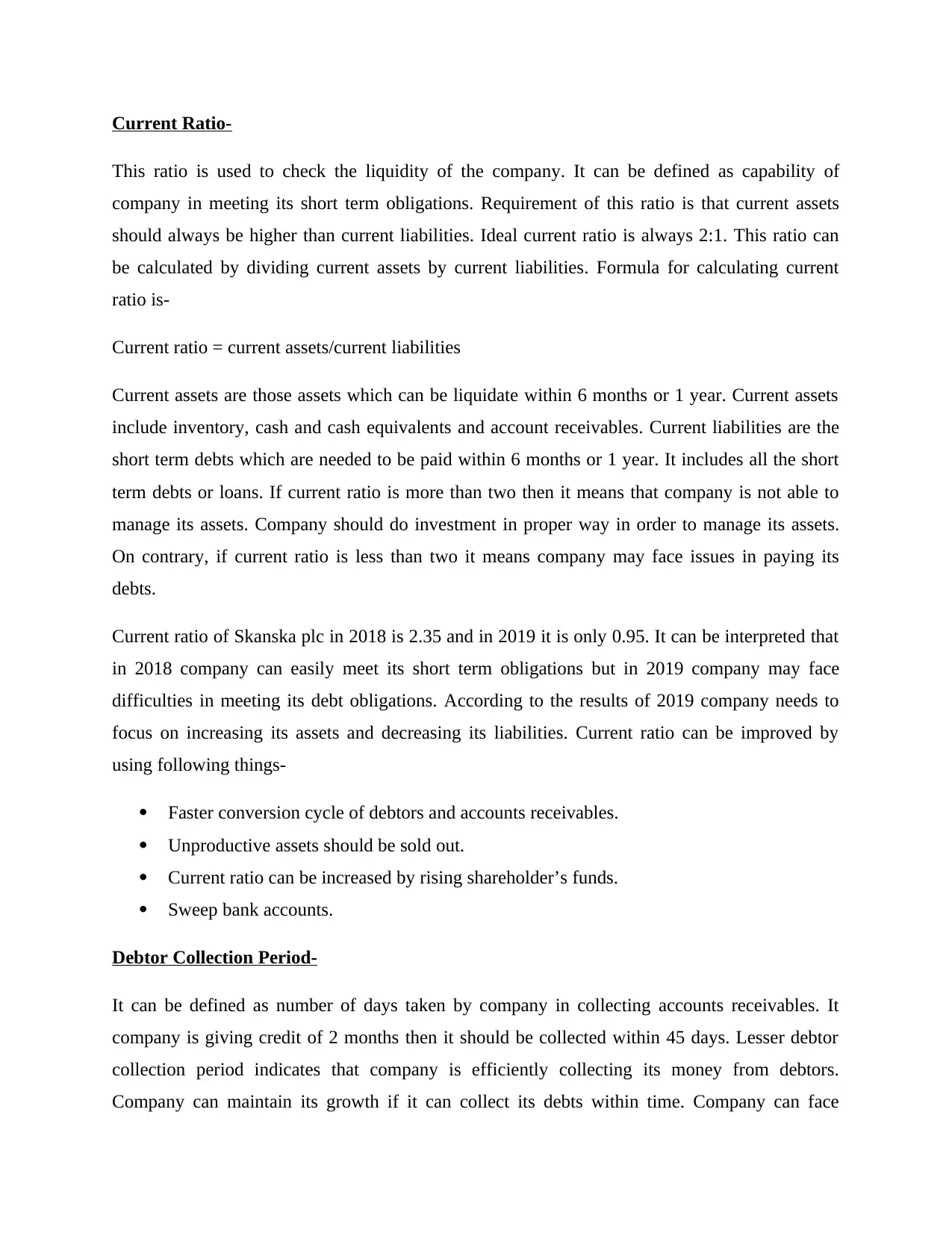
Current Ratio-
This ratio is used to check the liquidity of the company. It can be defined as capability of
company in meeting its short term obligations. Requirement of this ratio is that current assets
should always be higher than current liabilities. Ideal current ratio is always 2:1. This ratio can
be calculated by dividing current assets by current liabilities. Formula for calculating current
ratio is-
Current ratio = current assets/current liabilities
Current assets are those assets which can be liquidate within 6 months or 1 year. Current assets
include inventory, cash and cash equivalents and account receivables. Current liabilities are the
short term debts which are needed to be paid within 6 months or 1 year. It includes all the short
term debts or loans. If current ratio is more than two then it means that company is not able to
manage its assets. Company should do investment in proper way in order to manage its assets.
On contrary, if current ratio is less than two it means company may face issues in paying its
debts.
Current ratio of Skanska plc in 2018 is 2.35 and in 2019 it is only 0.95. It can be interpreted that
in 2018 company can easily meet its short term obligations but in 2019 company may face
difficulties in meeting its debt obligations. According to the results of 2019 company needs to
focus on increasing its assets and decreasing its liabilities. Current ratio can be improved by
using following things-
Faster conversion cycle of debtors and accounts receivables.
Unproductive assets should be sold out.
Current ratio can be increased by rising shareholder’s funds.
Sweep bank accounts.
Debtor Collection Period-
It can be defined as number of days taken by company in collecting accounts receivables. It
company is giving credit of 2 months then it should be collected within 45 days. Lesser debtor
collection period indicates that company is efficiently collecting its money from debtors.
Company can maintain its growth if it can collect its debts within time. Company can face
This ratio is used to check the liquidity of the company. It can be defined as capability of
company in meeting its short term obligations. Requirement of this ratio is that current assets
should always be higher than current liabilities. Ideal current ratio is always 2:1. This ratio can
be calculated by dividing current assets by current liabilities. Formula for calculating current
ratio is-
Current ratio = current assets/current liabilities
Current assets are those assets which can be liquidate within 6 months or 1 year. Current assets
include inventory, cash and cash equivalents and account receivables. Current liabilities are the
short term debts which are needed to be paid within 6 months or 1 year. It includes all the short
term debts or loans. If current ratio is more than two then it means that company is not able to
manage its assets. Company should do investment in proper way in order to manage its assets.
On contrary, if current ratio is less than two it means company may face issues in paying its
debts.
Current ratio of Skanska plc in 2018 is 2.35 and in 2019 it is only 0.95. It can be interpreted that
in 2018 company can easily meet its short term obligations but in 2019 company may face
difficulties in meeting its debt obligations. According to the results of 2019 company needs to
focus on increasing its assets and decreasing its liabilities. Current ratio can be improved by
using following things-
Faster conversion cycle of debtors and accounts receivables.
Unproductive assets should be sold out.
Current ratio can be increased by rising shareholder’s funds.
Sweep bank accounts.
Debtor Collection Period-
It can be defined as number of days taken by company in collecting accounts receivables. It
company is giving credit of 2 months then it should be collected within 45 days. Lesser debtor
collection period indicates that company is efficiently collecting its money from debtors.
Company can maintain its growth if it can collect its debts within time. Company can face
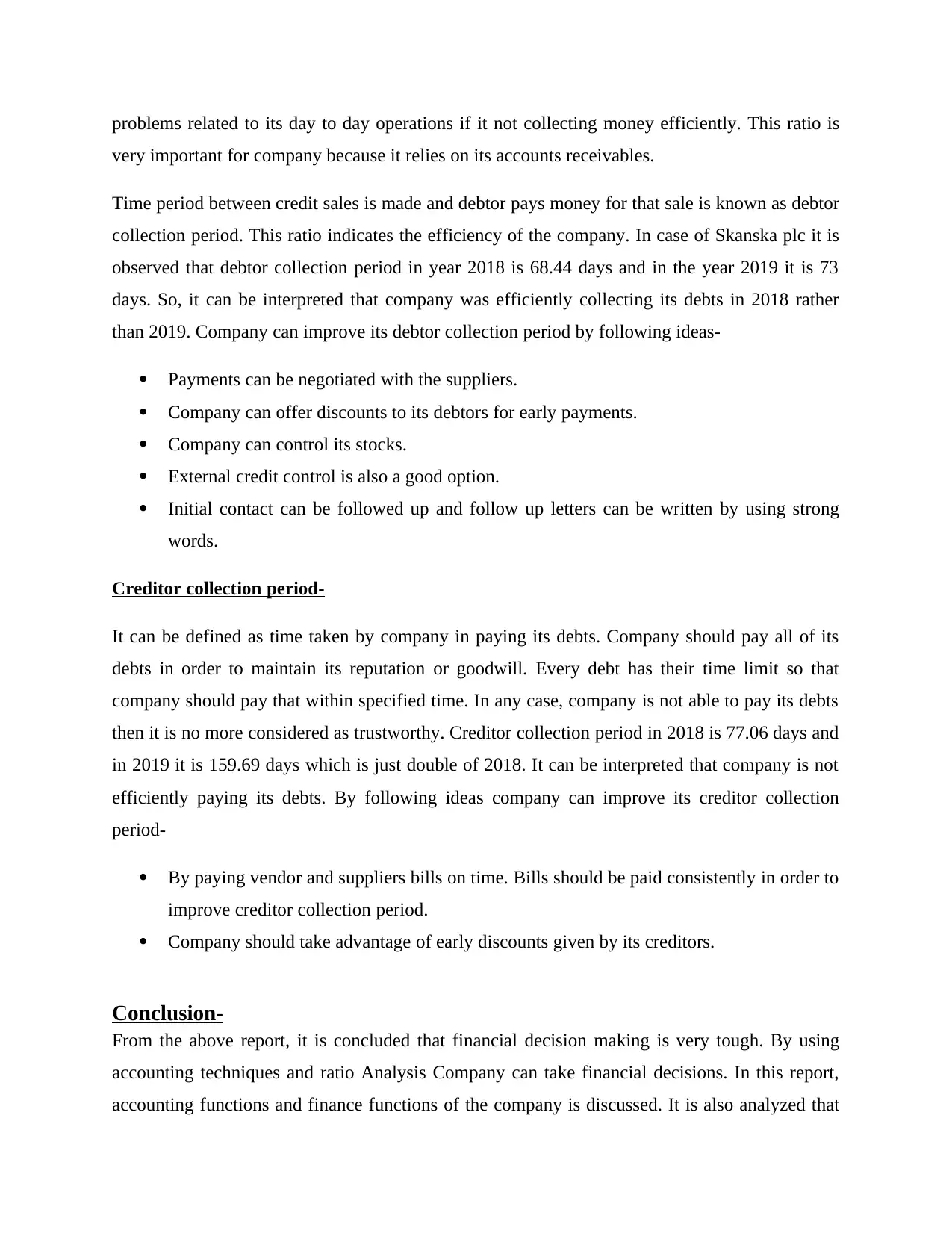
problems related to its day to day operations if it not collecting money efficiently. This ratio is
very important for company because it relies on its accounts receivables.
Time period between credit sales is made and debtor pays money for that sale is known as debtor
collection period. This ratio indicates the efficiency of the company. In case of Skanska plc it is
observed that debtor collection period in year 2018 is 68.44 days and in the year 2019 it is 73
days. So, it can be interpreted that company was efficiently collecting its debts in 2018 rather
than 2019. Company can improve its debtor collection period by following ideas-
Payments can be negotiated with the suppliers.
Company can offer discounts to its debtors for early payments.
Company can control its stocks.
External credit control is also a good option.
Initial contact can be followed up and follow up letters can be written by using strong
words.
Creditor collection period-
It can be defined as time taken by company in paying its debts. Company should pay all of its
debts in order to maintain its reputation or goodwill. Every debt has their time limit so that
company should pay that within specified time. In any case, company is not able to pay its debts
then it is no more considered as trustworthy. Creditor collection period in 2018 is 77.06 days and
in 2019 it is 159.69 days which is just double of 2018. It can be interpreted that company is not
efficiently paying its debts. By following ideas company can improve its creditor collection
period-
By paying vendor and suppliers bills on time. Bills should be paid consistently in order to
improve creditor collection period.
Company should take advantage of early discounts given by its creditors.
Conclusion-
From the above report, it is concluded that financial decision making is very tough. By using
accounting techniques and ratio Analysis Company can take financial decisions. In this report,
accounting functions and finance functions of the company is discussed. It is also analyzed that
very important for company because it relies on its accounts receivables.
Time period between credit sales is made and debtor pays money for that sale is known as debtor
collection period. This ratio indicates the efficiency of the company. In case of Skanska plc it is
observed that debtor collection period in year 2018 is 68.44 days and in the year 2019 it is 73
days. So, it can be interpreted that company was efficiently collecting its debts in 2018 rather
than 2019. Company can improve its debtor collection period by following ideas-
Payments can be negotiated with the suppliers.
Company can offer discounts to its debtors for early payments.
Company can control its stocks.
External credit control is also a good option.
Initial contact can be followed up and follow up letters can be written by using strong
words.
Creditor collection period-
It can be defined as time taken by company in paying its debts. Company should pay all of its
debts in order to maintain its reputation or goodwill. Every debt has their time limit so that
company should pay that within specified time. In any case, company is not able to pay its debts
then it is no more considered as trustworthy. Creditor collection period in 2018 is 77.06 days and
in 2019 it is 159.69 days which is just double of 2018. It can be interpreted that company is not
efficiently paying its debts. By following ideas company can improve its creditor collection
period-
By paying vendor and suppliers bills on time. Bills should be paid consistently in order to
improve creditor collection period.
Company should take advantage of early discounts given by its creditors.
Conclusion-
From the above report, it is concluded that financial decision making is very tough. By using
accounting techniques and ratio Analysis Company can take financial decisions. In this report,
accounting functions and finance functions of the company is discussed. It is also analyzed that
⊘ This is a preview!⊘
Do you want full access?
Subscribe today to unlock all pages.

Trusted by 1+ million students worldwide
1 out of 15
Related Documents
Your All-in-One AI-Powered Toolkit for Academic Success.
+13062052269
info@desklib.com
Available 24*7 on WhatsApp / Email
![[object Object]](/_next/static/media/star-bottom.7253800d.svg)
Unlock your academic potential
Copyright © 2020–2025 A2Z Services. All Rights Reserved. Developed and managed by ZUCOL.





